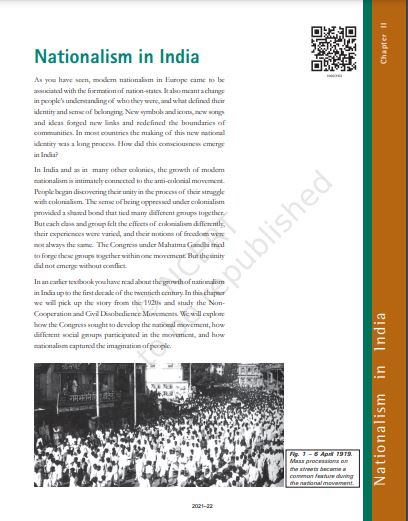Nationalism in India Class 10 PDF Quick download link is given at the bottom of this article. You can see the PDF demo, size of the PDF, page numbers, and direct download Free PDF of ‘Nationalism in India’ using the download button.
Nationalism in India Class 10 TextBook PDF Free Download

What Is Nationalism In India?
As you have seen, modern nationalism in Europe is associated with the formation of nation-states.
It also meant a change in people’s understanding of who they were, and what defined their identity and sense of belonging.
New symbols and symbols, new songs and ideas created new relationships and redefined the boundaries of communities.
The creation of this new national identity was a long process in most countries. How did this consciousness arise in India?
In India and as in many other colonies, the development of modern nationalism is closely linked to the anti-colonial movement.
The people began to discover their unity in the process of their struggle with colonialism.
The feeling of being oppressed under colonialism provided a common bond that bound many different groups together.
But each class and group felt the effects of colonialism differently, had different experiences, and did not always have the same ideas about freedom.
The Congress under the leadership of Mahatma Gandhi tried to unite these groups under one movement.
But the unity did not come without struggle.
In the previous textbook, you read about the growth of nationalism in India till the first decade of the twentieth century.
In this chapter we will take up the story of 1920s and study the non-cooperation and civil disobedience movements.
We will find out how the Congress tried to develop the national movement, how different social groups participated in the movement and how nationalism captured the imagination of the people.
World War I, Khilafat and Non-Cooperation In the years following 1919, we see the national movement expanding into new areas, involving new social groups and developing new methods of struggle.
How do we understand these developments? What were their implications?
First, the war created a new economic and political situation.
This led to a huge increase in defense expenditure which was financed by war loans and increased taxes: customs duties were raised and an income tax was introduced.
Prices rose during the war years – doubling between 1913 and 1918 – causing extreme hardship for the common people.
Villages were called upon to supply troops and forced recruitment in rural areas caused widespread anger.
Then in 1918–19 and 1920–21, crops failed in many parts of India, resulting in severe food shortages. Along with this was the influenza pandemic.
According to the 1921 census, 12 to 13 million people died as a result of famine and pestilence.
People hoped that after the end of the war, their difficulties would end.
But that did not happen. At this stage a new leader appeared and suggested a new method of struggle.
| Author | NCERT |
| Language | English |
| No. of Pages | 22 |
| PDF Size | 4.9 MB |
| Category | History |
| Source/ Credits | ncert.nic.in |
Nationalism in India Class 10 Book PDF Free Download
